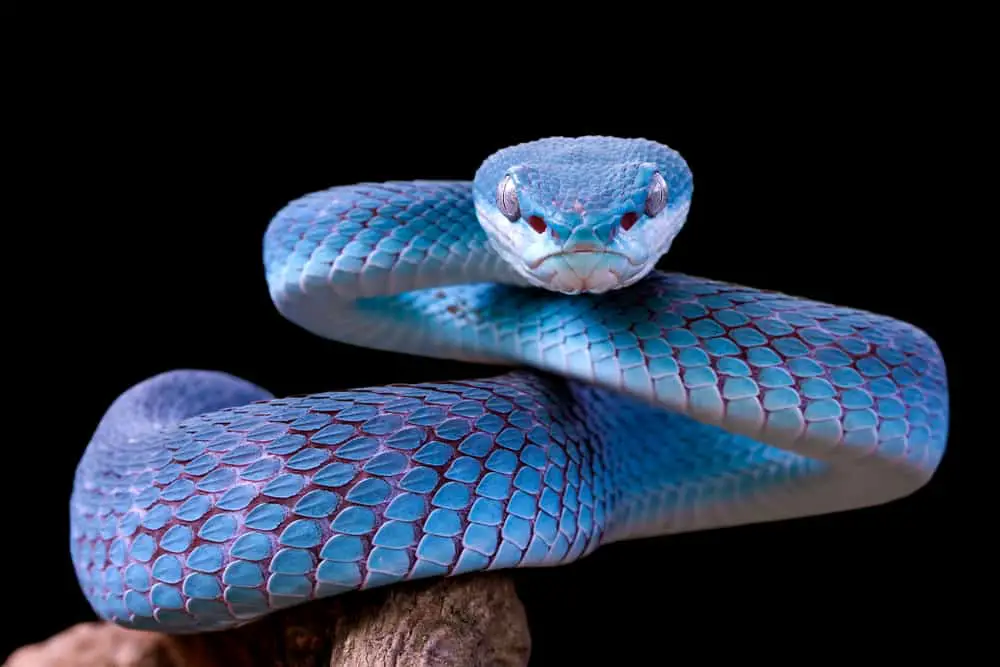
There are approximately 200 members of species that belong to the Viper (Viperidae) family. The Viper is a highly developed species; its sophisticated design is revealed in its fangs, scales, predatory tactics, habits, and behaviors resulting from progressive, evolutionary adaptation.
The Viper (Viperidae family) is divided into three subdivisions: Viperinae, Crotalinae, and Azemiopinae. The Viperinae is known as True Viper. Heat-detecting sacs distinguish Crotalinae or Pit Vipers from other Viperids. Azemiopinae is commonly known as Fea Vipers; it is the most primitive Viper.
The Viper is one of the most dangerous serpents across the globe. The lethal injection of its fangs carries highly advanced venom, the product of 60 million years of evolution. Viper bites result in many reported death cases per year.
Table of Contents
- Types of Vipers
- Conclusion
Types of Vipers
Numerous species belong to the Viperidae family; this is subdivided into Viperinae, Crotalinae, and Azemiopinae. They all share common characteristics and features that distinguish the Viperidae.
The Common Characteristics of the Viper

The Viper is so named as it is viviparous; vivi– living and parere– to beget; this means it gives birth to live young. Ovoviviparous describes the hatching of eggs within their bodies and birth live infants. They are the only species of snake to do this, although there are members that oviparous; this is to lay and hatch eggs.
Almost all vipers have vertical, or elliptical, slit-shaped pupils that vary in different sizes per species. Their vertically shaped pupils allow Vipers to detect the physical world on the light ray spectrum at a more extensive range.
The primary physical trait that hallmarks the Viper is its triangular head; this is relevant as the shape accommodates the trademark massive fangs and the toxic glands attached to the upper back jaw.
The fangs are a fascinating feature of the Viperidae family. The fangs are elongated, hollow, and hinged as they fold back. They lie across the top surface of the Viper’s mouth when not used and are enclosed in a membrane. Venom travels through the hollow fangs.
The two fangs sit at the front of the Viper’s mouth and serve as a conduit for the poison generated from the glands to penetrate prey. The fangs are attached to a rotatory maxillary bone, accommodating their relaxed position and capacity to ambush strike at prey. The fangs can rotate individually and together.
The Viper can open its mouth close to 180-degrees when striking at prey. The fangs hinge open at the utmost second to prevent damage. The Viper can also strike a dry bite, as it takes time for the glands to generate venom; it can decide the amount of venom it wants to inject.
The Viper produces several types of venom. The venom consists of protease; these are enzymes that disintegrate proteins. The effects of protease include bleeding, swelling, pain, necrosis (death in cells, tissues, and organs due to absence of blood supply), and impairment of the blood’s coagulation.
Most vipers have keeled scales; these scales are unique for their ridged quality as other species have smooth scales. There are many advantages to possessing carinated scales, including no reflected light off scales assisting camouflage, and keeled scales create warning crackle to ward off predators, incapacitate prey.
Vipers are ambush predators that strike prey with extremely swift dexterity. Usually, Vipers are nocturnal and are listless and slow-moving; the reason for this is their reliance on camouflage for protection and not quick retreat. However, they have a swift strike; the African Puff Adder can strike at a quarter of a second.
The Viperinae
The Viperinae is a subdivision of the Viper family. They are identified by the absence of heat detection sac-like organs that belong to Crotaline or Pit Vipers.
Atheris- Bush Vipers
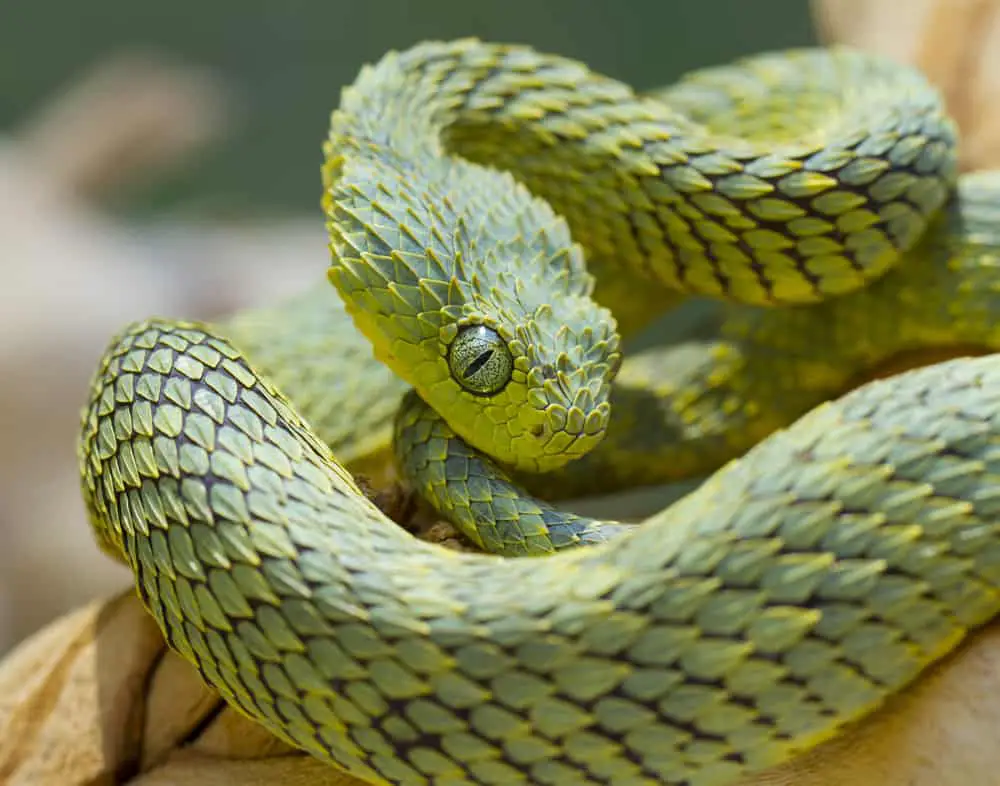
This poisonous snake resides solely in Sub-Saharan Africa; these small snakes range from 22 inches to 31 inches. They are arboreal and reside in forests and rainforest regions. They have a highly developed prehensile tail; this means that the end of their tail can support the weight of their body hanging from branches.
Currently, there are 17 species acknowledged. They are ovoviviparous, hatching eggs while still in the body, giving birth to live snakes.
Bitis- Puff Adders

A toxic breed of snake located in Africa and the Southern Arab Peninsula, there are currently 15 species to this division. They are ovoviviparous.
The Puff Adder makes up both the smallest and largest vipers of the entire family. The size difference between members is extreme, with minute snakes at 11 inches at one end to 6.6 feet at the other end of the spectrum.
They exhibit a unique behavior of swelling and collapsing their bodies while hissing and puffing audibly. They are ambush hunters with exceptional striking speed.
Causus- Night Adder

Some scientists who study snakes (ophiology) classify the Night Adder as a unique division, called Causinae, the fourth subdivision of Viperidae, but generally, Causus is classed under Viperinae.
The poisonous night adder is argued to be the primeval or proto-type Viper; this is due to its round pupils, its oviparity, head scalation, and venom instruments.
The night adder’s head is covered with nine broad, large, proportioned plates that are slightly distinct from its neck; this differs from other Vipers whose head is significantly distinguished from its neck and blanketed in numerous miniature scales.
The fangs of the Causus differ as well; they don’t possess the hinge feature integral to other Vipers and are comparatively short.
Night Adders frequently are active during the day as well as the night. If provoked, they can lift the top half of their bodies from a coil to strike.
Cerastes- Horned Vipers
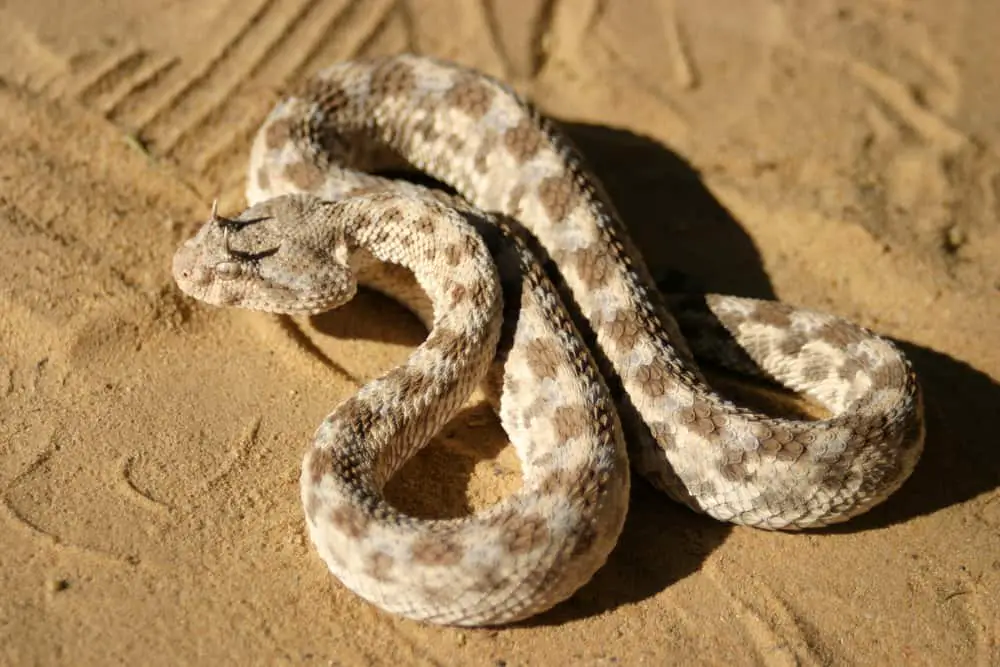
These are small species that are found in North Africa, Arabia, and Iran. Its size averages at 20 inches. It has unique supraorbital horns over each eye, which is an extension of its carinated scales.
The horns are not always a consistent feature of the Cerastes genus, and even the same littler will not produce horns on every serpent. The horns are a solitary, elongated spine-like scale that can crease backward into a groove. They bend when stimulated, thereby streamlining the head and facilitating movement.
This genus is nocturnal and resides mainly in the desert; they are terrestrial and bury themselves in the sand; they are generally slow; however, when they sidewind across the sand, they move quickly.
The Cerastes retains a general equanimity except if provoked; then it will coil and rub its keeled scales together, creating a warning cracking, sizzling sound. It will strike from this position.
Echis- Saw Scaled Vipers or Carpet Vipers
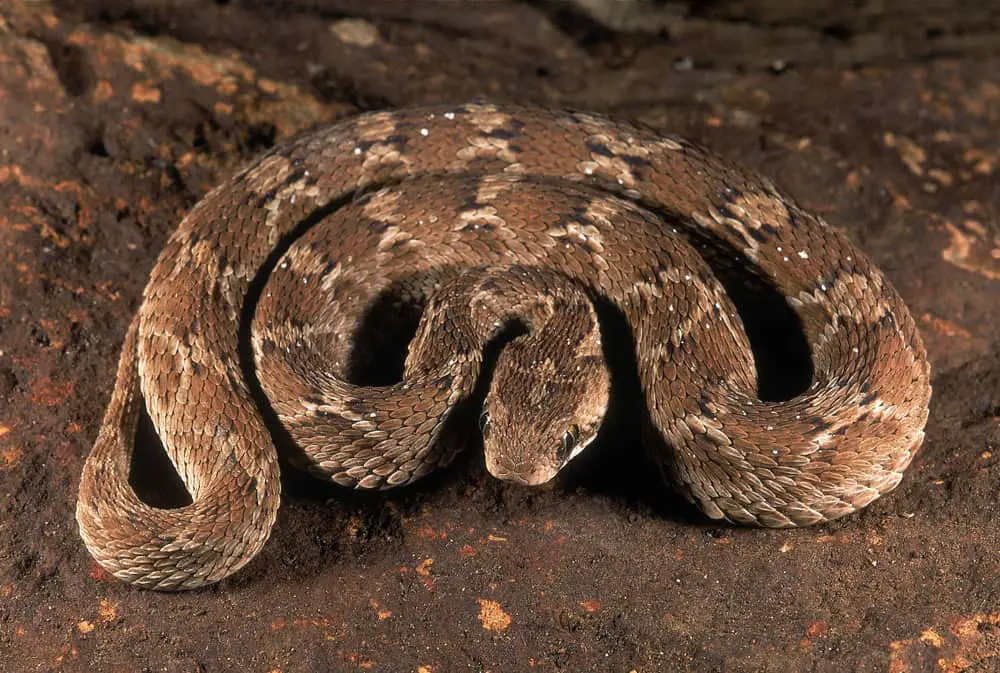
Echis is a translation of Latin from Greek- Viper. The common name, the Saw Scaled or Carpet Viper, is responsible for the most reported death cases from a snake bite worldwide. They are in Africa, the Middle East, India, Sri Lanka, and Pakistan.
Like the horned Viper, the Echis genus manipulates a crackling, rustling sound from coiling its body and rubbing its carinated scales together. The scales on these serpents are serrated keels. This threat display is termed stridulation.
There are 12 species of the Echis family. They have a fiercely aggressive temperament. The Echis in Africa is oviparous, and in India, Viviparous. The snake venom of the Echis comprises four different toxins: neurotoxins, cardiotoxins, hemotoxins, and cytotoxins.
Neurotoxins destroy nerve tissue. Cardiotoxins damages the heart’s muscles, and hemotoxins devastate red blood cells and impair the blood’s ability to clot. Cytotoxins are lethal to the body’s cells.
Macrovipera- Large Palearctic Vipers
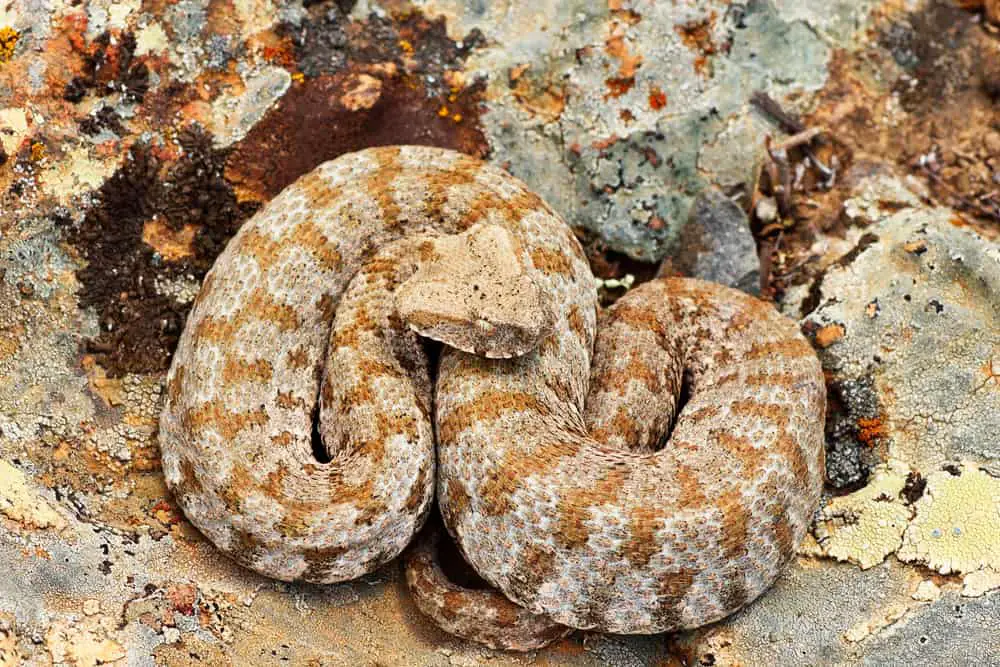
These snakes are belligerent, large, and liable for significant snake bite death cases annually. The Macrovipera inject more venom than the average Viper and are extremely dangerous; their size can exceed 4.9 feet.
They reside in the Palearctic regions: the Milo Archipelagos, in the Aegean Sea, the semi-dessert and steppes of North Africa, around and within the Middle East. This genus classifies three species. All Macrovipera are oviparous.
Pseudocerastes- False Horned Viper
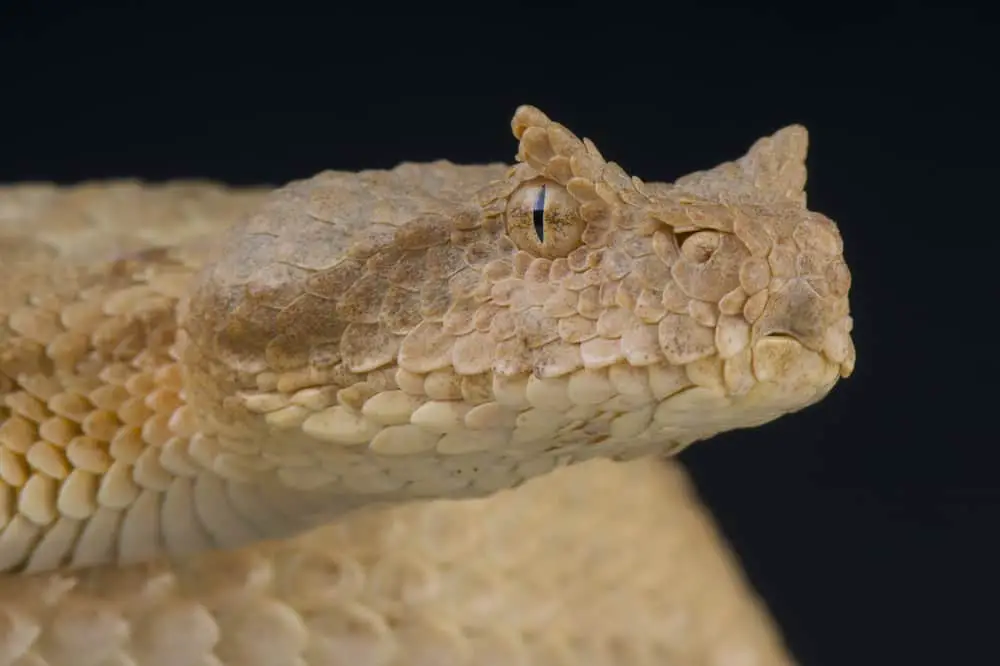
This genus is called the False Horn Viper as their supraorbital horns are a compact layering of scales as opposed to the Horned Viper with its proper, single supraorbital spine.
These are poisonous snakes found solely in the Middle East and Asia. There are currently three species acknowledged that belong to this genus.
Crotalinae
The Crotalinae is generally referred to as Pit Vipers or Crotaline Vipers; from ancient Greece, krotalon– castanet or rattle of a rattlesnake. The Pit Vipers are the only Viperids located in America.
Crotalinae are identified by a heat-detecting sac-like organ (pit) positioned between the eye and nostrils on both sides of the head. This fossa or indentation in the loreal area is what makes Crotalinae unique.
The loreal pits open to sensitive infrared-detecting organs, and these permit Vipers to sense warm-blooded creatures. As prey comes into the perimeter of the Viper, the infrared radiation falls on a membrane and alerts the Viper of the prey’s presence and direction.
Together, these pits enhance the Viper’s predatory capacity with thermal rangefinder characteristics; therefore, when hunting at night and the Viper is deprived of sight, the loreal pits will inform the range of prey with precise accuracy.
Agkistrodon- Moccasins
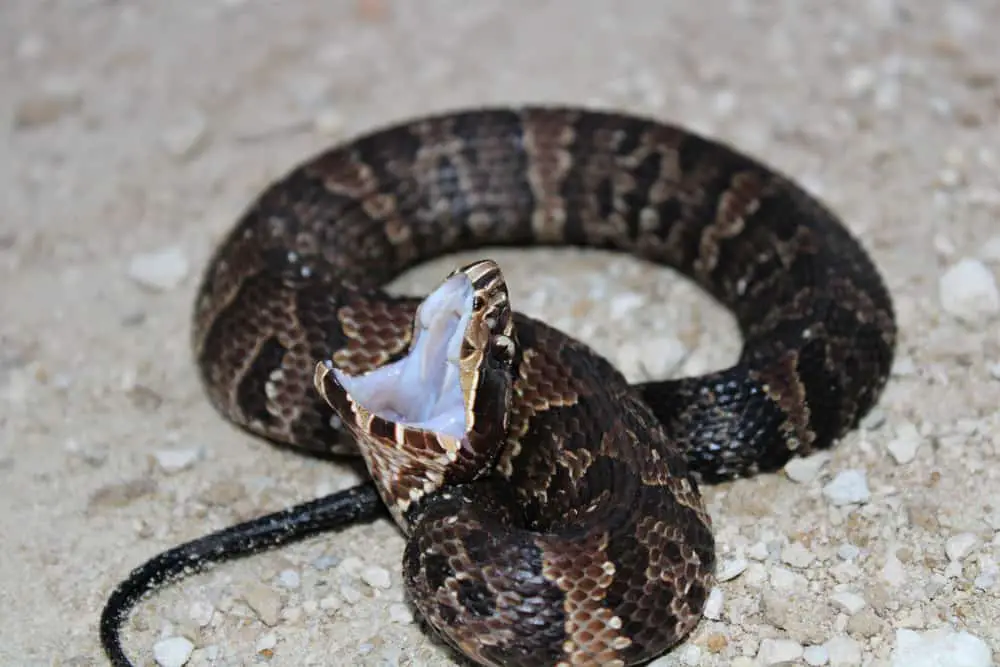
This species is endemic to North America; is generally referred to as American Moccasins. There are eight species currently identified with this genus. As with all Pit Vipers, they are venomous.
Commonly recognizable Vipers include cottonmouths, copperheads, and cantils. The origins of the name Agkistrodon derive from Greek ankistron, which translates to fishhook, and this is a reference to its fangs. Moccasin’s origin is unknown.
These Vipers are semi-aquatic to terrestrial and are frequently discovered proximate to pools of water. All members of this genus are ovoviviparous.
Bothreichis- Palm Vipers or Palm-Pit Vipers
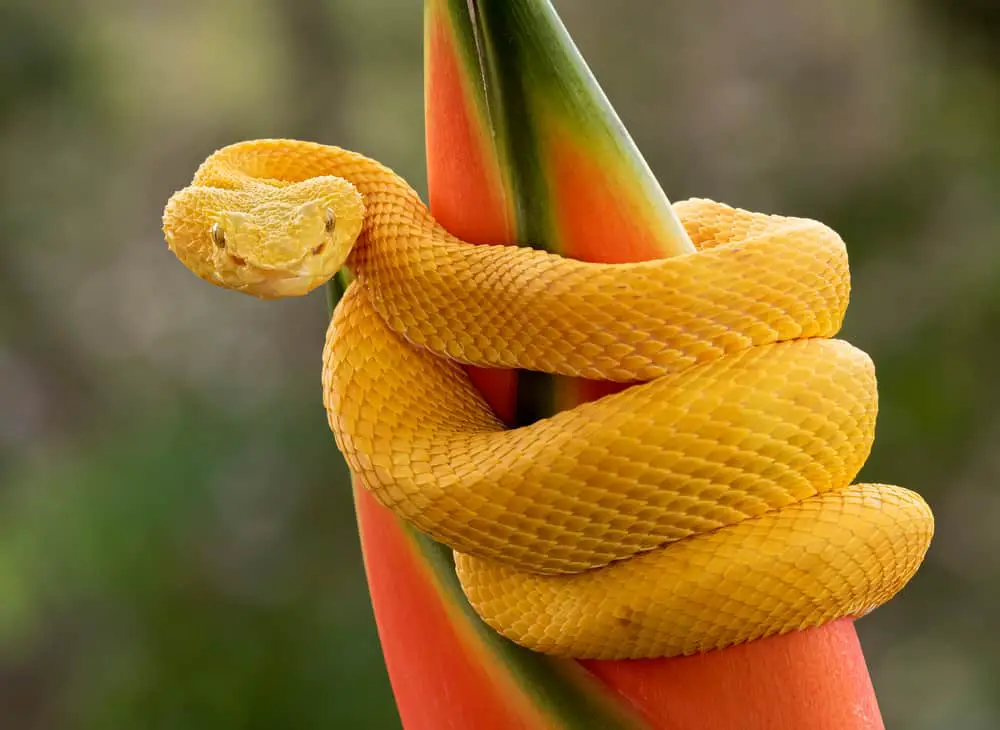
The Palm Viper is prevalent in Mexico and Central America; they are arboreal. Their coloring usually is green; the eyelash viper is an exception to this rule. They have a highly developed prehensile tail that takes up 15% of their body.
If the Bothreichis is located approximately 5000 feet above sea level, they are diurnal or active during the day; if they are positioned about 3300 feet below, they are nocturnal or active at night. If located in any area in between 5000 and 3300 feet, they are active at any time.
Bothrops- Lanceheads
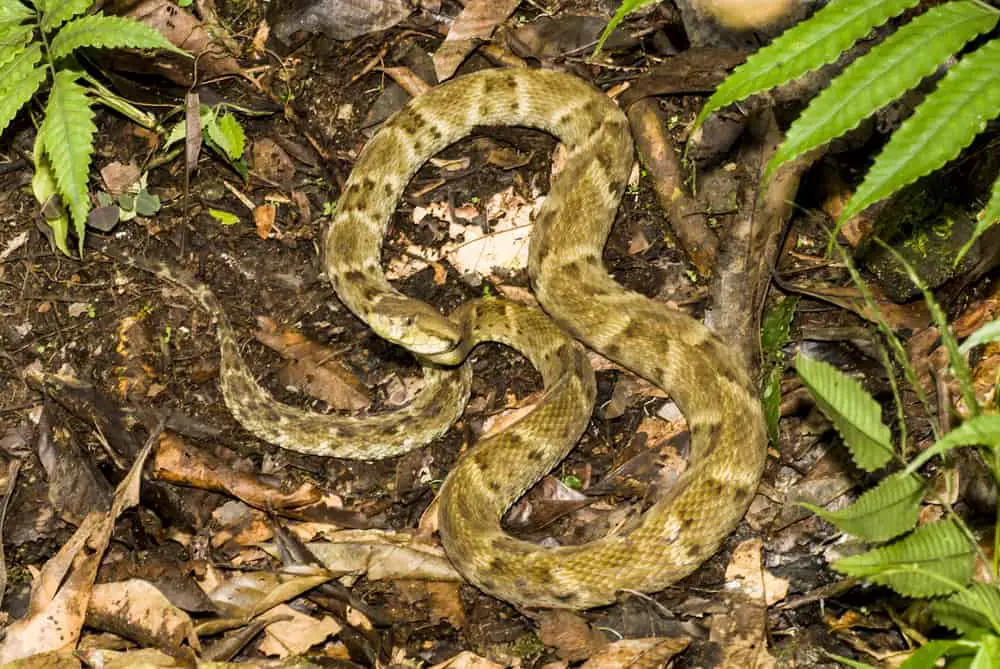
Lanceheads are incredibly poisonous and endemic to Central and South America. Specimens of this genus are liable for more human deaths in South America than any other. There are 45 species currently belonging to Bothrops.
These Vipers vary from 19.5 – 27.5 inches to 6.6 feet in length. Mainly they are nocturnal and terrestrial, but at higher altitudes, they are active during the day. Many of the various species vigorously vibrate their tail when enticed.
Crotalus- Rattlesnakes
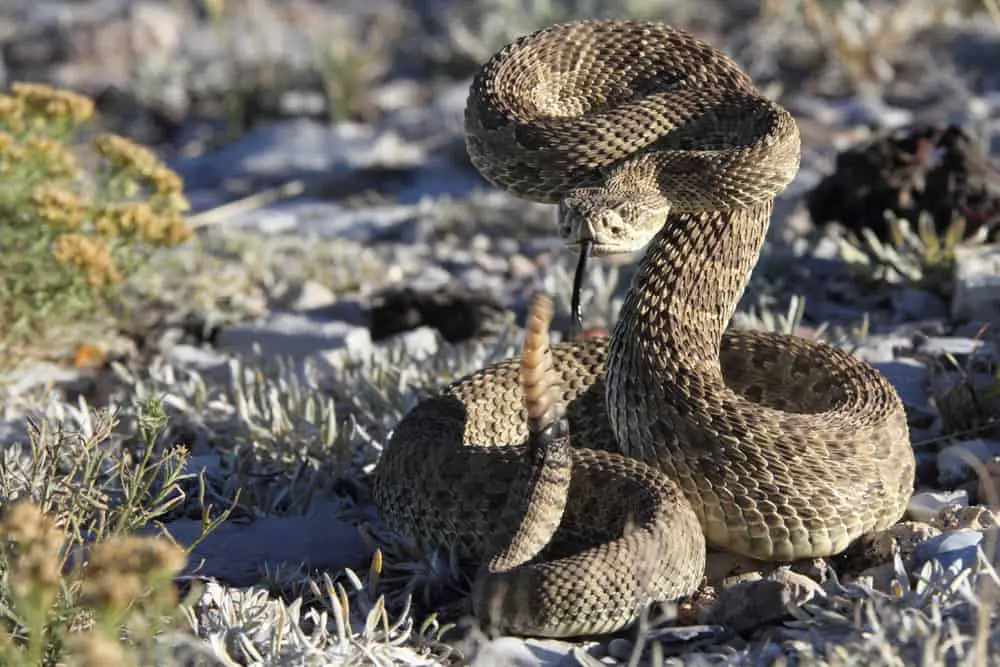
The Crotalus’ vernacular term is the Rattlesnake, Greek krotalon, which translates to castanet or rattle; this describes the distinctive tail-end rattle that this Viper exhibits when triggered.
The rattle is composed of loose, interlocking hollow shells at the endpoint of the tail; this produces an audible rattle when vibrating.
Constituents of this genus span in length from 20-28 inches to 59 inches. It is ovoviviparous.
Gloydius- Asian Moccasins

This genus is endemic to Asia and is like the North American Agkistrodon.
Ovophis- Mountain Pit Viper
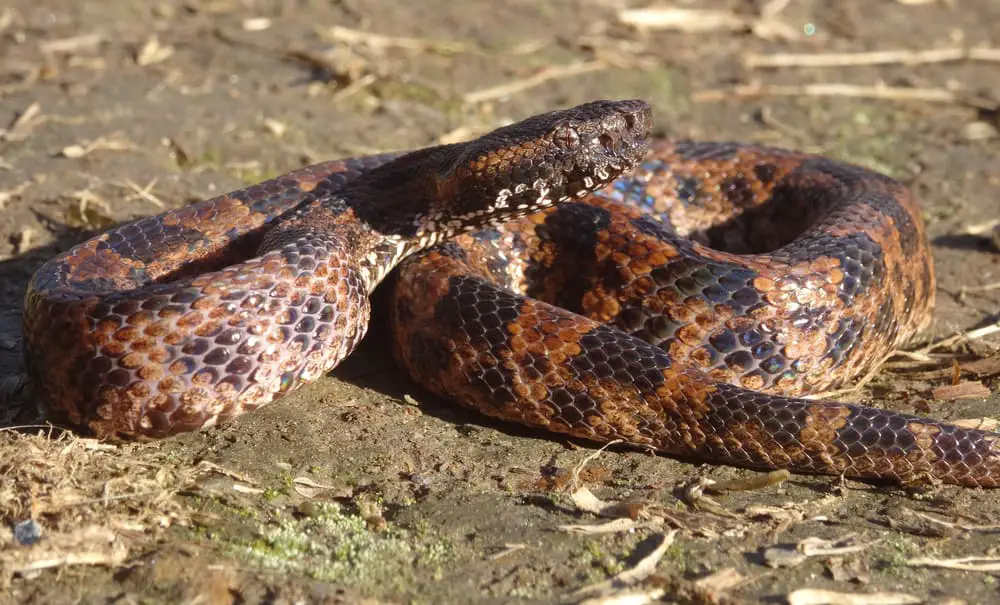
The Ovophis is a genus of poisonous Vipers located in Asia; currently, there are six recognized species.
Porthidium- Hognose Pit Vipers
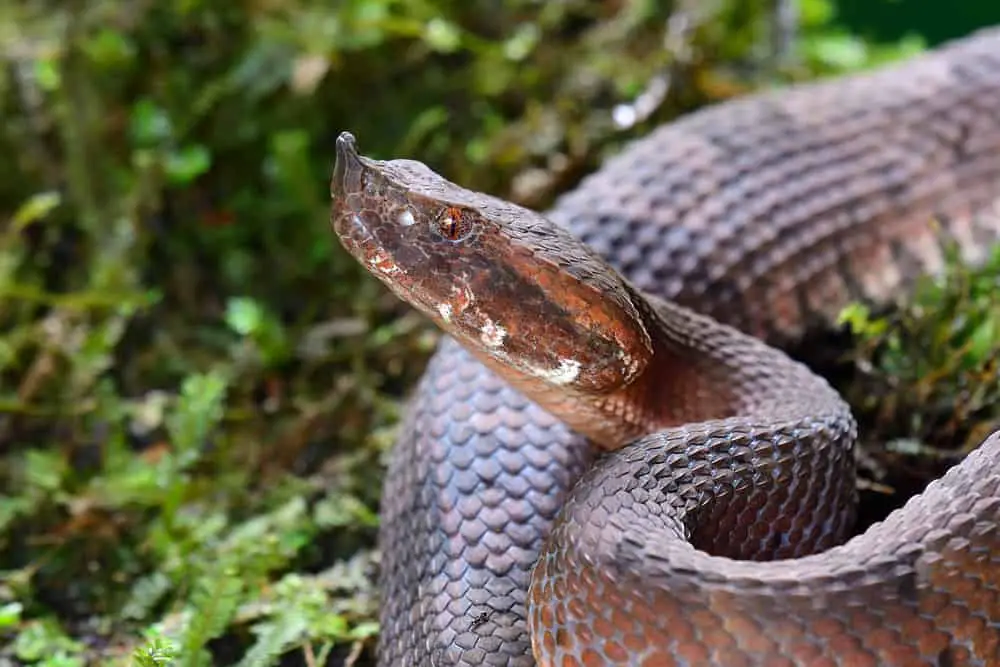
This genus is situated in Mexico and the northern region of South America. The etymology derives from Greek portheo that translates to destroy.
The Porthidium species is a small species that is 22-30 inches long as an adult. As of August 2016, nine species are acknowledged in this genus.
Protobothrops- Pit Vipers
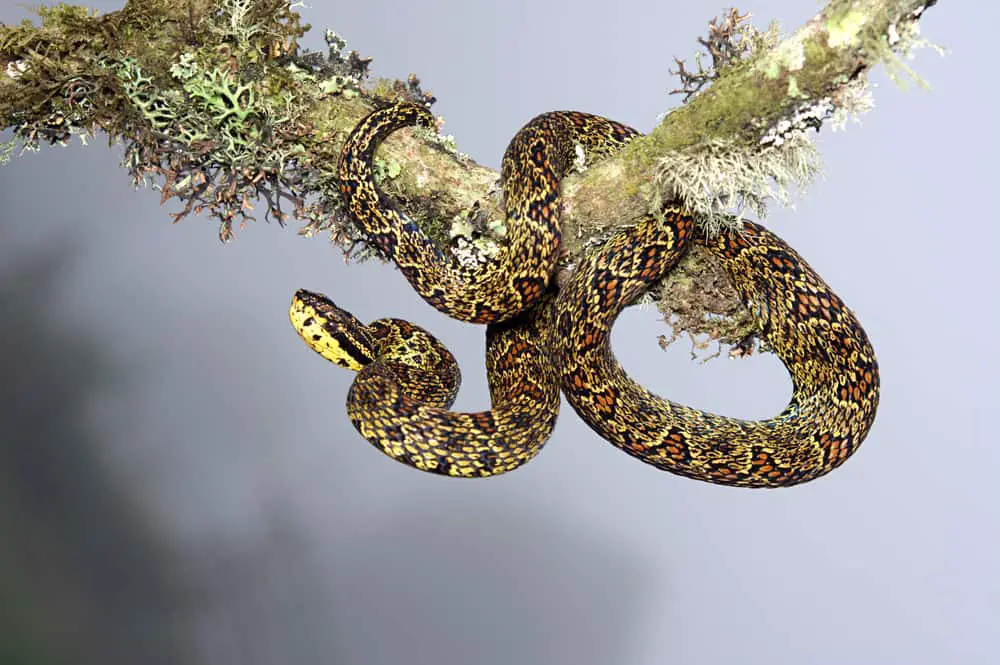
The Protobothrops have a diverse range of venom that is unique compared to other snakes. The reason for the specialized, advanced venom is due to the location and habitat.
The prey is posited as the reason why this serpent has rapidly advanced diversification of the venom-related genes.
Different members reside across different parts of Asia Vietnam, China, Japan, the Ryukyu Islands, Tibet, Myanmar, Thailand.
Trimeresurus- Pit Viper
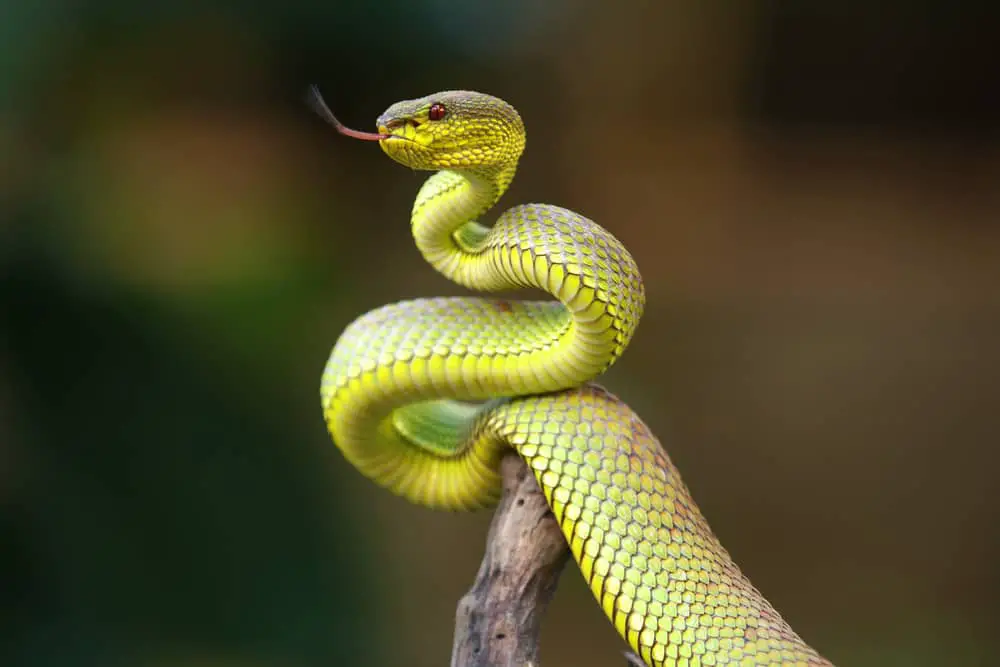
This genus is in Asia from the Indian Subcontinent to Southeast Asia, China, and the Pacific Islands. There are about 50 species acknowledged to this genus. There are colloquially referred to as Asian Palm Pit Vipers and Asian Lanceheads.
Most specimens are relatively small and mainly arboreal, with narrow bodies and prehensile tails. Primarily they are green, yet there are many colors like orange, red, black, yellow, and gold markings.
Tropidolaemus- Temple Pit Vipers
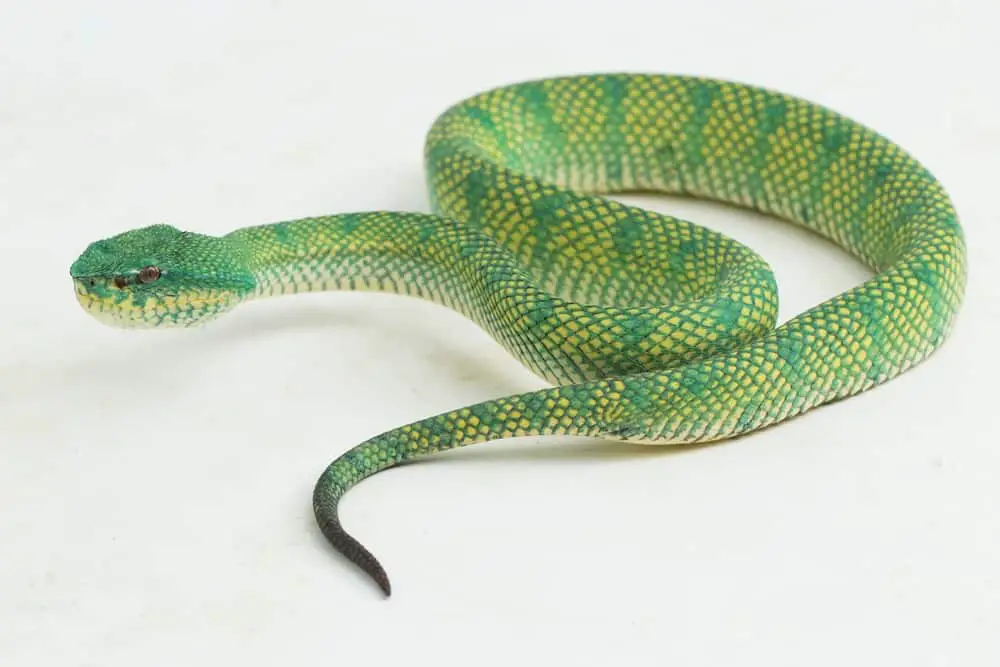
The Temple Pit Vipers are in India and Southeast Asia. There are currently five species acknowledged as this genus.
Tropidolaemus are sexually dimorphic; this means that each gender is unique to the other beyond reproductive capabilities. Females grow to approximately 39 inches in length and males to about 30 inches.
They are identified by different phases that showcase different colors and patterns. Phases differ from black or brown base color with orange and or yellow stripes or green foundation color and variation therein.
They are mainly arboreal and advanced climbers. The Temple Viper hangs motionless throughout the day, anticipating prey. Depending on the temperature, they are diurnal or nocturnal.
Azemiopinae- Fea Vipers

The Fea Viper is understood to be the most primitive Viper for numerous reasons. The Fea Viper possesses a moderately sturdy body and tiny tail. The dorsal scales are smooth and not keeled like its Viperinae and Crotalinae cousins.
The head is more elliptical and not triangular, accommodating those highly evolved venomous glands of the Viperid genus; the Fea glands are small.
The scales are not small, tightly packed, and plentiful instead, there are several large, broad plates; this resembles two other serpentine families: the colubrid and elapid.
Unlike the other Viperids, the Fea Viper is oviparous and hibernates throughout winter. The Fea Viper region is found in northern Vietnam, China, Southeast Myanmar, and Southeast Tibet.
The Fea Viper has its threat display behavior. If triggered, it flattens its body, attempting to make itself seem more prominent and formidable. Its jaws then flare outward to fake a triangular head. Occasionally it vibrates its tail.
Conclusion
There are three subdivisions of the Viperidae family: Viperinae, Crotalinae, and Azemiopinae. The Viper has an identifying triangular head with sophisticated venom glands and hinged fangs. It has keeled scales that serve the Viper in numerous ways, including camouflage and threat display.
The Crotalinae has infrared heat-seeking sacs in the loreal region of its head that detects prey in the dark. The other members of the Viperidae family don’t have these. The Azemiopinae or Fea is the primitive serpent of the three subdivisions.
References:
Britannica: Viper Snake
Animals Mom: Kinds of Vipers
Live Science: Vipers
Conservation News: What Are Vipers
Science Direct: Pit Viper
Science Direct: Viperinae
Science Direct: Genetics of Viperinae
Animals Mom: 10 Facts Abouts Viper Snakes
DK Find Out: Vipers
Study: Viper Snake Facts Lesson for Kids
Kids: Viper
Britannica Kids: Viper
ThoughtCo: Vipers
NWF: The Private Lives of Pit Vipers
iNaturalist: Viperinae
New World Encyclopedia: Viperinae
Youtube: Facts About Snakes
Youtube: Vipers: Nature’s Most Dangerous Noodles
BioKids: Viperinae
Britannica: Old World Viper
